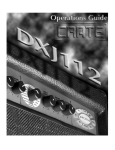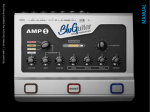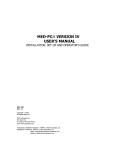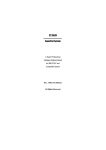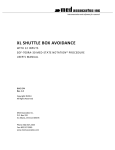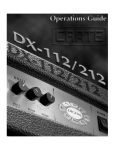Download Alesis RA100 Specifications
Transcript
ALESIS Monitor One Reference Manual TABLE OF CONTENTS CHAPTER 1: ABOUT THE MONITOR ONE 1.0 A LITTLE HISTORY ............................................... 2 CHAPTER 2: INSTALLATION 2.0 2.1 2.2 SPEAKER PLACEMENT........................................ 4 CONNECTIONS .................................................... 7 POWER AND PROTECTION .................................. 8 CHAPTER 3: SPECIFICATIONS AND SERVICE 3.0 3.1 SPECIFICATIONS................................................. 1 0 3.0A Architectural and Engineering Specifications...........11 MAINTENANCE /REPAIR INFORMATION .............. 1 0 3.1A Cleaning...........................................................................10 3.1B Service .............................................................................11 CHAPTER 1: ABOUT THE MONITOR ONE Your new Alesis Monitor One™ Studio Reference Monitors will deliver accurate mixes in near-field digital and analog studio monitoring applications. The Monitor Ones offer wide frequency response, accurate transient reproduction, clear imaging and high power handling capability and were designed by experts with decades of experience in professional loudspeaker design. This speaker system uses a proprietary 6.5" high-power low frequency driver with a special mineral-filled polypropylene cone, a highly damped linear rubber surround and a 1.5" diameter voice coil wound on a high-temperature Kapton former. The 1" high frequency driver employed has a soft natural silk dome and is ferrofluid cooled. The system's crossover network uses low dielectric loss non-polarized capacitors and an oversized low-loss low frequency inductor. Rear panel connections are made via 5way binding posts suited to large diameter wires as well as banana plugs. The cabinet design uses Alesis' exclusive SuperPort™ speaker venting technology. Most small speakers used for near-field monitoring give disappointing results in their lowest frequency range. They are either sealed (which limits the amount of air the driver can move) or have an undersized vent whose function at low frequencies and high acoustic output is nullified by the effect of turbulence in the restricted port tube. The Monitor One's large folded SuperPort overcomes this limitation by minimizing vent turbulence at high air velocities, thereby ensuring that the enclosure tuning remains stable, the acoustic output remains linear during heavy low frequency attack transients, and that the reactive load above and below box resonance seen by the driving amplifier does not dynamically shift in frequency. This all translates to tighter bass with higher definition. The Monitor One's 4 ohm load impedance takes advantage of today's modern professional amplifiers which are generally capable of a 1-3 dB increase in output power with 4 ohm loads over their 8 ohm ratings. The result is a similar increase in the Monitor One's acoustic output over conventional 8 ohm monitors. Reliable handling of this additional acoustic output is ensured by the Monitor One's substantial power handling capability. Typical near-field monitors are rated at 50-60 watts maximum whereas the Monitor One carries a 120 watt continuous power rating and has 1 been successfully tested to over 200 watts using the industry standard EIA-426A method. This a rugged speaker system designed for serious professional use. Covered with a non-slip rubber textured laminate for stable mounting, the Monitor Ones come in a mirror image left/right pair for symmetrical horizontal mounting. 1.0 A LITTLE HISTORY In the early days of recording, most recording studios used big monitor speakers almost exclusively. Unfortunately, they also required high powered amplifiers and expensive acoustic treatment (often poorly done) of the entire control room. Still, a well-constructed big monitoring system really was impressive to listen to, a fact not overlooked by the studio owners who wanted to impress the record company executives who paid for the big studio's time. These big systems had big level control knobs, and clients enjoyed "cranking-up" the volume. Fortunately, recording engineers and producers eventually learned that this was not the best way to accurately mix music because it wasn't the way people listened to their radios, cassettes and CD players (metalheads excepted). Also, big monitor systems and the costs for the required control room acoustic treatments were going through the roof (no pun intended), particularly beyond the budget limits of smaller project and home studios which were growing in numbers. A new way of accurate monitoring was needed: near-field monitoring. Near-field monitors, by their definition, are intended for mounting close to the listener. The idea here is to improve the direct acoustic path between the speaker and the listener by making it shorter, thereby giving less opportunity for the always present indirect (reflected) sounds to get back in and muddle things up. With near-field monitoring, the surrounding acoustic environment becomes a much less significant factor in establishing the monitor system's sound character. A good set of small monitors properly placed in a reasonably non-reverberant room and powered by a 100-watt amplifier will yield surprisingly accurate results at budget prices. Carried to another studio, the same monitor should also provide repeatable results. In fact, some recording engineers carry their own speakers around because they know how they will sound in almost any room. Now, even the big studios use smaller speakers 2 to augment their big monitoring systems, and near-field monitors have become proven tools in the recording business. 3 CHAPTER 2: INSTALLATION Like any speaker system, your Monitor Ones will work best when properly positioned in a suitable acoustic environment. Achieving proper speaker placement is usually straightforward, but even with near-field monitors, speaker placement and the acoustics of the listening room itself are too often overlooked and can become significant contributors to an inaccurate and uninspiring monitoring environment. Please take a moment to read this information carefully. It will help you to get the most use and enjoyment from your new Alesis monitors. 2.0 SPEAKER PLACEMENT While near-field monitors are more forgiving of the surrounding room acoustics, it is always prudent to optimize the listening environment whenever possible. First, the user should be aware of the effect that the size of the listening room can have on low frequency response. In general, the smaller the room, the stronger the bottom end will be, although placement within a larger room can also make a difference. This has to do with the way low-frequency waves travel in closed spaces. If you find your monitor system to be either light or heavy on the bottom, try moving them around within your listening room. Also, because the Monitor One's SuperPort tube is located at the rear, position the monitors at least six inches away from anything that would block it. You should avoid locating your Monitor Ones near reflective surfaces such as glass, tile, large open walls or table tops. Still, many rooms used for recording have these surfaces, so the best way to deal with them is to place the monitors out in the room away from reflective walls, windows and sizable objects. Even with these reflective surfaces separated from the monitoring position, typical mixing situations usually still have the top surface of the mixing board to deal with. Unfortunately, the board itself can be a major source of reflections and the additional acoustic conduction into the board can affect your monitor's amplitude and phase response. Speaker placement on the console's meter bridge provides for two clear acoustic paths between the speakers and the recording engineer which results in undesirable comb filtering effects and poor imaging. The first path is the direct one, and the second is via a reflection off the mixer main 4 control panel (as shown in Figure 1 below). This kind of speaker placement also couples acoustic energy from the speaker's cabinet more readily into the console's chassis. Both conditions should be reduced by placing the speakers on their own stands acoustically detached from, and slightly behind, the console as shown in Figure 2. In this location, the reflective path off the console's control panel is now blocked by the meter bridge. Figure 1 Direct Path Re flec tion Monitors placed on the console’s meter bridge can directly radiate back onto the console control panel causing a strong delayed reflection at the listening position Figure 2 Direct Path voids ath A —6”— Minimum ole Cons tP Direc Random Reflections Moving the monitors to a position behind the meter bridge causes the bridge to block the offending reflective path Careful consideration should also be given to the physical spacing between the speakers. Alesis recommends that the distance between the speakers equal the distance between the listener and either speaker. In other words, the listener and the two speakers are at the three corners of a triangle having equal- length sides. Figure 3 shows this concept. Note that both speakers are turned in somewhat, so that the prime listening position is directly out in front of each speaker. Applications that require monitoring by 5 more than one engineer are accommodated by a smaller rotation of the cabinets. This will widen the prime listening position somewhat. Figure 3 Ri or gh nit o ft M tM on ito Le r The speakers and listener should be at the three corners of a triangle having equal length sides Prime Listening Position Alesis has designed the Monitor Ones for horizontal mounting. This keeps their height profile as low as possible to minimize the recording engineer's visual obstructions. Your Monitor Ones are supplied as a symmetrical left-right pair, and if used this way, should be installed with the soft dome high frequency drivers towards the outsides of the triangle. The high frequency driver should be on the left side of the left monitor and on the right side of the right monitor (see Figure 4 below). Of course, the traditional method of mounting the speakers with the high frequency drivers at the top is perfectly acceptable too. Figure 4 TM TM The high frequency driver should be on the left side of the left monitor and on the right side of the right monitor 6 The Monitor Ones are completely covered with a non-slip rubber textured laminate whereas other speakers provide small stick-on pads (or nothing at all) to keep them from slipping around while they are playing. If you need to move the Monitor Ones or adjust their position slightly, lift them off the mounting surface first rather than attempting to slide them. 2.1 CONNECTIONS Professional grade 5-way binding posts are provided for external wiring to the amplifier. This type of connector can accommodate bare or tinned wires, banana plugs and even spade lugs. About Wire: A lot of hype and confusion exists about the type of speaker wires to use, most of it created by the wire manufacturers themselves in an effort to have a unique story to tell. While this expensive wire will not hurt the speaker's performance at all, Alesis does not subscribe to most of this hype and chooses to take an approach based on science when recommending speaker wire. Our recommendation is simple; use the shortest length of the largest diameter wire you can get. #12-14 gauge multi-stranded speaker wire found at most hi-fi stores works very well. This kind of wire resembles oversized lamp cord and is very easy to work with. Before connecting the speakers, make sure your amplifier is turned OFF before making connections to it. Be sure you get the + terminals of the speakers wired to the + terminals of the amplifier. To help you do this, most speaker cable has a way to tell one conductor from another. Some use different-colored wires or insulation; others mold a small line or marker into one insulator to mark it. If one speaker's polarity is out of phase with the other, the result will be loss of low frequency response and stereo imaging when the system is played. In most cases, the speaker outputs of the amplifier will have a red terminal and a black terminal; these should be connected to the same-colored terminals of the Monitor One. Consult the manual of your power amplifier for specific information. In a properly-phased system, a positive input to the amplifier should result in a positive voltage on the red terminal, and push the driver forward. If you are using a dual banana plug connector, one side of the 7 plug usually has a "GND" marker molded on it so you can keep polarity straight after unplugging and replugging. In standard practice, the GND side connects to the black terminal of the speaker. To connect wires to the terminals if you are not using a banana plug: 1. Strip about 1/2" (15 mm) of insulation from the ends of each wire. If the wire is stranded, twist the strands together at the end. 2. Turn the red and black terminal caps counter-clockwise until they reach their limit. As you do, the hole through the terminal post will be exposed. 3. Insert the wires into the holes, observing proper polarity. 4. Tighten the terminal caps so that they hold the wire firmly. Make sure no insulation is caught inside the terminal, to avoid a loose connection. 2.2 POWER AND PROTECTION Alesis recognizes that professional speakers need to be strong to survive, so the Monitor One is designed to handle twice the power of other near-field monitors. This was achieved by using proprietary high power drivers and oversized crossover components, choices made principally to offer the user an extended margin of safety. Therefore, an amplifier with a 100 watt power rating into 4 ohms, like the Alesis RA-100™ Reference Amplifier, is recommend for most monitoring situations. Higher or lower power amplifiers may be used, depending on the size of the listening room and the engineer's preference for normal working levels. Be sure to verify that your amplifier is rated for 4 ohm speakers. Some older amplifiers are not and may fail if overloaded. Alesis is not responsible for any failures caused by the use of an inproperly-rated amplifier. Also, there is no situation where an amplifier rated beyond 200 watts should ever be used because of the danger of damaging the Monitor One. To do so is asking for trouble and will void your warranty. On the other hand, if you use too small of a power amplifier, it is possible to damage the Monitor One if you run it into heavy clipping and distortion in an effort to get sufficient volume. This can lead to failures of both the amplifier and the speaker, as 8 the amplifier’s clipping generates high frequency energy sufficient to damage the high frequency driver. Alesis does not suggest the use of any external protection devices, but considers such devices as fuses, lamps and/or thermal breakers safe to use, so long as they do not cause failures or require modifications to the Monitor One's construction which would void the warranty. Actually, many such devices are generally considered ineffective and can additionally alter the speaker's sound character, an undesirable trait for a studio monitor. The best protection against speaker failure is to mix at a reasonable listening level. Alesis thanks you for choosing our products. We value any comments you may have about this monitor system, this manual, your Alesis dealer and about our factory service. Please take a minute now to fill out your warranty card and tell us what you think. ®Alesis is a registered trademark of Alesis Corporation. Monitor One, SuperPort, and RA-100 are trademarks of Alesis Corporation 9 CHAPTER 3: SPECIFICATIONS AND SERVICE 3.0 SPECIFICATIONS Drivers: 6.5" low frequency, 1" silk dome high frequency 2.5 kHz, 2nd-order filters (12 dB per octave) 45 Hz - 18 kHz, ±3 Crossover: Frequency Response: dB Power Handling: 120 watts program, 200 watts peak (using EIA426A method) 4 ohms 88 dB SPL @ 1 watt and 1 meter on axis Rubber textured laminate over 5/8" MDF with Alesis SuperPort on rear Nominal Impedance: Sensitivity: Cabinet: Dimensions: 8.5"D Weight: 15"W x 9.25"H x 15 lb. each 3.0A Architectural and Engineer's Specifications The loudspeaker cabinets shall each contain a 6.5" low frequency and a 1" silk dome high frequency driver, and be equipped with a passive crossover network with a crossover frequency of 2.5 kHz. The low frequency driver shall have a mineral-filled polypropylene cone, a damped linear rubber surround and a 1.5" diameter voice coil wound on a high-temperature Kapton former. The high frequency driver shall be ferrofluid cooled. The crossover network shall consist of a low-pass section feeding the 6.5" driver and a high-pass section connected to the 1" driver, with 2nd-order filters in each section using low dielectric loss non-polarized capacitors and an oversized low-loss low frequency inductor. Each cabinet shall be equipped with two 5-way binding posts for electrical connection to an amplifier recessed into the back of the cabinet. These posts shall accept heavy-gauge wire, standard banana plugs, or spade lugs. The cabinet shall be constructed of 5/8" thick MDF and be 10 covered in a dark grey rubber textured laminate. The cabinet shall have a large folded vent port tuned to extend the response of the low-frequency driver, using Thiele-Small parameter calculations adjusted for the effects of turbulence in the port during high-power operation. The cabinet shall measure 15" wide, 9.25" high, and 8.5" deep, and weigh 15 pounds (Metric specification: 38.1 cm x 23.5 cm x 21.6 cm, 6.8 kilograms). Each assembly shall exhibit a frequency response from 45 Hz to 18 kHz, plus or minus 3 dB. Its impedance shall be 4 ohms, and be capable of handling 120 watts program material or 200 watts peak input using the EIA-426A testing method. It shall generate an 88 dB sound pressure level, measured at 1 meter with a 1 watt power input. The loudspeakers shall be the Monitor One Studio Reference Monitors from Alesis Corporation. 3.1 MAINTENANCE/REPAIR INFORMATION 3.1A Cleaning The cabinet surfaces of the Monitor One are covered with a textured rubber laminate. Clean these surfaces when necessary with a lint-free cloth dampened in warm soapy water. To preserve the textured finish, don't rub hard on the surface. Do not attempt to clean the cabinet with a brush (which may damage the surface) or a sponge (which may leave small crumbs in the texture). Do not attempt to clean either of the drivers. The Monitor Ones require no periodic maintenance. 3.1B Service Before sending the Monitor Ones in for repair, make sure they are faulty and that the problem isn't being caused by something else in the system. Distortion or noise may be caused by a defective amplifier, preamp, cable, equalizer etc., or a loose connection in the system. Connect the Monitor Ones to a system that is known to be working properly to check whether the monitors have malfunctioned. Should service become necessary, YOU MUST FIRST CONTACT ALESIS TO OBTAIN A RETURN AUTHORIZATION NUMBER BEFORE RETURNING THE UNIT TO ALESIS OR AN AUTHORIZED ALESIS SERVICE FACILITY. If the unit is to be 11 repaired under warranty, you must provide a copy of the original sales receipt as evidence of date of purchase. Repairs will be made under warranty only after Alesis or an Authorized Service Center has determined in its sole discretion through inspection that the failure was not the result of overpowering, abuse, power surges, or defective components ahead of the Monitor One. OPENING THE MONITOR ONE OR ALTERING ANY OF ITS COMPONENTS WILL VOID THE FACTORY WARRANTY. To obtain repair after the warranty period, contact your dealer or Alesis. Outside the United States, contact your local distributor for repair information. 12















